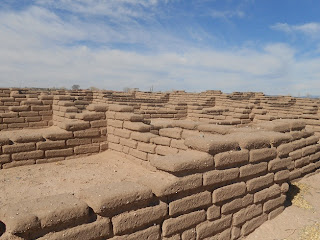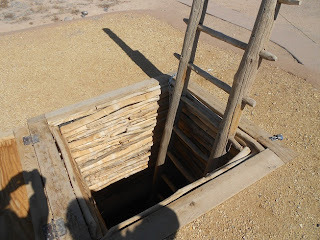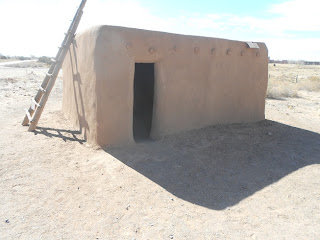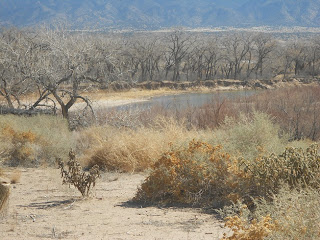 |
| Coronado State Monument ruins |
The 1933 Excavation
The Kuaua Pueblo, located on the west bank of the Rio Grande north of Albuquerque, was first excavated in the 1930's by the Great Depression era WPA workforce. The excavation was directed by qualified archeologists. The excavation project at the Kuaua Pueblo came about when archeologists while digging discovered a site with three walls which turned out to be a pueblo kiva. Incredibly, the walls also had painted murals. The Coronado State Monument was established in 1935, just a few years after the WPA excavation began.
 |
| Kiva entrance |
The murals were layered on sheets of plaster and peeled off the walls and were preserved. The murals which number thirteen are on display at the monument's Visitor Center. The murals are considered to be the finest examples of pre-Columbian art in North America. Native American and Spanish Colonial artifacts are on display in the Visitor Center which was designed by John Gaw Meem. Meem was born in Brazil in 1894 to Episcopal Church missionaries. He migrated to the United States in 1910 where he attended the Virginia Military Institute and graduated with a civil,engineering degree. In 1933 Meem was appointed as the official architect at the University of New Mexico in Albuquerque.
Coronado's Expedition of the Southwest and the Pueblo Indians
In the year 1540, Francisco Vasquez de Coronado set out from Mexico on his epic expedition which covered the present states of Arizona, New Mexico, Kansas and Texas. Many may remember that the Coronado Expedition was seeking the "Seven Cities of Gold". Unfortunately, Coronado never did locate those golden cities but he did come across many Native adobe villages.
 |
| Restored adobe home |
Many historians believe that the Coronado Expedition wintered in the Rio Grande Valley where they discovered twelve Tiwa speaking pueblos. This cluster of pueblos is now called the Tiguex Province. While there is some disagreement among scholars as to where exactly Coronado camped in this area, many contend that the winter camp was at the site of the Kuaua Pueblo. Some also contend that the specific location was decided upon because of it's abundance of food.
 |
| View of Rio Grande from Kuaua Pueblo |
It's interesting to note that after Coronado returned to Mexico City in 1542, it would be another fifty years before any Spanish conquistador would return to the region. In 1598 Juan de Onate journeyed north from Mexico City and established Santa Fe as the capital of “New Spain". Onate's party also included missionaries whose purpose was to convert the Native population to Christianity. The Spaniards also handed out land grants to settlers. The Native population was expected to provide labor and convert to Christianity while the Spaniards would protect them from attack by nomadic tribes. As the history books contend, this was the beginning of the subjugation of the pueblo Natives which ultimately resulted in the Pueblo Revolt of 1680.
Another interesting historical note is that the Coronado Expedition left behind three Franciscan padres who were all martyred within two years.
Also see our Western Trips articles on the:
New Mexico Cliff Dwellings
Old Town Albuquerque Spanish Mission
Pecos National Historical Park Pueblo Ruins
Things to See and Do in La Jolla California
 |
| Coronado State Monument Visitor Center |
Today's visitor to the Coronado State Monument can explore the Kuaua Pueblo ruins via a self guided walking tour. You will also be able to climb into a reconstructed kiva to see the reproduced murals. A good tip is to find out in the visitor center when one of the docents will be giving a kiva tour. This is a great way to explore the ruins and learn the history of the murals and the Kuaua Pueblo. This is the perfect addition to your New Mexico vacation planner as it's fun, educational and very low cost.
While touring the Albuquerque area you'll find the Coronado State Monument at Kuaua Pueblo easy to reach. Coronado State Monument and the Kuaua Pueblo ruins are located west of the town of Bernalillo on Hwy 550. The site is about a 19 mile drive north of Albuquerque. The quickest way there is via Interstate 25 and exiting at Hwy 550. The site is on the west bank of the Rio Grande about 2 miles west of the Interstate.
(Photos from author's private collection)
View Larger Map

